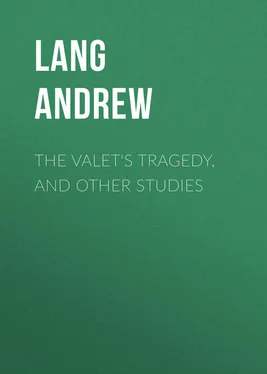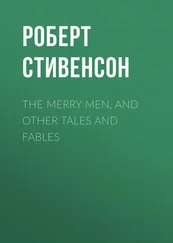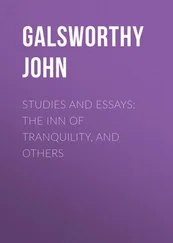Andrew Lang - The Valet's Tragedy, and Other Studies
Здесь есть возможность читать онлайн «Andrew Lang - The Valet's Tragedy, and Other Studies» — ознакомительный отрывок электронной книги совершенно бесплатно, а после прочтения отрывка купить полную версию. В некоторых случаях можно слушать аудио, скачать через торрент в формате fb2 и присутствует краткое содержание. Издательство: Иностранный паблик, Жанр: foreign_antique, foreign_prose, на английском языке. Описание произведения, (предисловие) а так же отзывы посетителей доступны на портале библиотеки ЛибКат.
- Название:The Valet's Tragedy, and Other Studies
- Автор:
- Издательство:Иностранный паблик
- Жанр:
- Год:неизвестен
- ISBN:нет данных
- Рейтинг книги:4 / 5. Голосов: 1
-
Избранное:Добавить в избранное
- Отзывы:
-
Ваша оценка:
- 80
- 1
- 2
- 3
- 4
- 5
The Valet's Tragedy, and Other Studies: краткое содержание, описание и аннотация
Предлагаем к чтению аннотацию, описание, краткое содержание или предисловие (зависит от того, что написал сам автор книги «The Valet's Tragedy, and Other Studies»). Если вы не нашли необходимую информацию о книге — напишите в комментариях, мы постараемся отыскать её.
The Valet's Tragedy, and Other Studies — читать онлайн ознакомительный отрывок
Ниже представлен текст книги, разбитый по страницам. Система сохранения места последней прочитанной страницы, позволяет с удобством читать онлайн бесплатно книгу «The Valet's Tragedy, and Other Studies», без необходимости каждый раз заново искать на чём Вы остановились. Поставьте закладку, и сможете в любой момент перейти на страницу, на которой закончили чтение.
Интервал:
Закладка:
To sum up, on July 1, 1669, the valet of the Huguenot intriguer, Roux de Marsilly, the valet resident in England, known to his master as ‘Martin,’ was ‘wanted’ by the French secret police. By July 19, a valet, of the highest political importance, had been brought to Dunkirk, from England, no doubt. My hypothesis assumes that this valet, though now styled ‘Eustache Dauger,’ was the ‘Martin’ of Roux de Marsilly. He was kept with so much mystery at Pignerol that already the legend began its course; the captive valet was said to be a Marshal of France! We then follow Dauger from Pignerol to Les Exiles, till January 1687, when one valet out of a pair, Dauger being one of them, dies. We presume that Dauger is the survivor, because the great mystery still is ‘what he HAS DONE,’ whereas the other valet had done nothing, but may have known Dauger’s secret. Again, the other valet had long been dropsical, and the valet who died in 1687 died of dropsy.
In 1688, Dauger, at Sainte-Marguerite, is again the source and centre of myths; he is taken for a son of Oliver Cromwell, or for the Duc de Beaufort. In June 1692, one of the Huguenot preachers at Sainte-Marguerite writes on his shirt and pewter plate, and throws them out of window.* Legend attributes these acts to the Man in the Iron Mask, and transmutes a pewter into a silver plate. Now, in 1689-1693, Mattioli was at Pignerol, but Dauger was at Sainte-Marguerite, and the Huguenot’s act is attributed to him. Thus Dauger, not Mattioli, is the centre round which the myths crystallise: the legends concern HIM, not Mattioli, whose case is well known, and gives rise to no legend. Finally, we have shown that Mattioli probably died at Sainte-Marguerite in April 1694. If so, then nobody but Dauger can be the ‘old prisoner’ whom Saint-Mars brought, masked, to the Bastille, in September 1698, and who died there in November 1703. However, suppose that Mattioli did not die in 1694, but was the masked man who died in the Bastille in 1703, then the legend of Dauger came to be attributed to Mattioli: these two men’s fortunes are combined in the one myth.
*Saint-Mars au Ministre, June 4, 1692.
The central problem remains unsolved,
WHAT HAD THE VALET, EUSTACHE DAUGER, DONE?*
*One marvels that nobody has recognised, in the mask, James Stuart (James de la Cloche), eldest of the children of Charles II. He came to England in 1668, was sent to Rome, and ‘disappears from history.’ See
‘The Mystery of James de la Cloche.’
II. THE VALET’S MASTER
The secret of the Man in the Iron Mask, or at least of one of the two persons who have claims to be the Mask, was ‘WHAT HAD EUSTACHE DAUGER DONE?’ To guard this secret the most extraordinary precautions were taken, as we have shown in the fore-going essay. And yet, if secret there was, it might have got wind in the simplest fashion. In the ‘Vicomte de Bragelonne,’ Dumas describes the tryst of the Secret-hunters with the dying Chief of the Jesuits at the inn in Fontainebleau. They come from many quarters, there is a Baron of Germany and a laird from Scotland, but Aramis takes the prize. He knows the secret of the Mask, the most valuable of all to the intriguers of the Company of Jesus.
Now, despite all the precautions of Louvois and Saint-Mars, despite sentinels for ever posted under Dauger’s windows, despite arrangements which made it impossible for him to signal to people on the hillside at Les Exiles, despite the suppression even of the items in the accounts of his expenses, his secret, if he knew it, could have been discovered, as we have remarked, by the very man most apt to make mischievous use of it – by Lauzun. That brilliant and reckless adventurer could see Dauger, in prison at Pignerol, when he pleased, for he had secretly excavated a way into the rooms of his fellow-prisoner, Fouquet, on whom Dauger attended as valet. Lauzun was released soon after Fouquet’s death. It is unlikely that he bought his liberty by the knowledge of the secret, and there is nothing to suggest that he used it (if he possessed it) in any other way.
The natural clue to the supposed secret of Dauger is a study of the career of his master, Roux de Marsilly. As official histories say next to nothing about him, we may set forth what can be gleaned from the State Papers in our Record Office. The earliest is a letter of Roux de Marsilly to Mr. Joseph Williamson, secretary of Lord Arlington (December 1668). Marsilly sends Martin (on our theory Eustache Dauger) to bring back from Williamson two letters from his own correspondent in Paris. He also requests Williamson to procure for him from Arlington a letter of protection, as he is threatened with arrest for some debt in which he is not really concerned. Martin will explain. The next paper is endorsed ‘Received December 28, 1668, Mons. de Marsilly.’ As it is dated December 27, Marsilly must have been in England. The contents of this piece deserve attention, because they show the terms on which Marsilly and Arlington were, or, at least, how Marsilly conceived them.
(1) Marsilly reports, on the authority of his friends at Stockholm, that the King of Sweden intends, first to intercede with Louis XIV. in favour of the French Huguenots, and next, if diplomacy fails, to join in arms with the other Protestant Powers of Europe.
(2) His correspondent in Holland learns that if the King of England invites the States to any ‘holy resolution,’ they will heartily lend forces. No leader so good as the English King – Charles II! Marsilly had shown ARLINGTON’S LETTER to a Dutch friend, who bade him approach the Dutch ambassador in England. He has dined with that diplomatist. Arlington had, then, gone so far as to write an encouraging letter. The Dutch ambassador had just told Marsilly that he had received the same news, namely, that, Holland would aid the Huguenots, persecuted by Louis XIV.
(3) Letters from Provence, Languedoc, and Dauphine say that the situation there is unaltered.
(4) The Canton of Zurich write that they will keep their promises and that Berne IS ANXIOUS TO PLEASE THE KING OF GREAT BRITAIN, and that it is ready to raise, with Zurich, 15,000 men. They are not afraid of France.
(5) Zurich fears that, if Charles is not represented at the next Diet, Bale and Saint Gal will be intimidated, and not dare to join the Triple Alliance of Spain, Holland, and England. The best plan will be for Marsilly to represent England at the Diet of January 25, 1669, accompanied by the Swiss General Balthazar. This will encourage friends ‘TO GIVE HIS BRITTANIC MAJESTY THE SATISFACTION WHICH HE DESIRES, and will produce a close union between Holland, Sweden, the Cantons, and other Protestant States.’
This reads as if Charles had already expressed some ‘desire.’
(6) Geneva grumbles at a reply of Charles ‘through a bishop who is their enemy,’ the Bishop of London, ‘a persecutor of our religion,’ that is, of Presbyterianism. However, nothing will dismay the Genevans, ‘si S. M. B. ne change.’
Then comes a blank in the paper. There follows a copy of a letter as if FROM CHARLES II. HIMSELF, to ‘the Right High and Noble Seigneurs of Zurich.’ He has heard of their wishes from Roux de Marsilly, whom he commissions to wait upon them. ‘I would not have written by my Bishop of London had I been better informed, but would myself have replied to your obliging letter, and would have assured you, as I do now, that I desire…’
It appears as if this were a draft of the kind of letter which Marsilly wanted Charles to write to Zurich, and there is a similar draft of a letter for Arlington to follow, if he and Charles wish to send Marsilly to the Swiss Diet. The Dutch ambassador, with whom Marsilly dined on December 26, the Constable of Castille, and other grandees, are all of opinion that he should visit the Protestant Swiss, as from the King of England. The scheme is for an alliance of England, Holland, Spain, and the Protestant Cantons, against France and Savoy.
Читать дальшеИнтервал:
Закладка:
Похожие книги на «The Valet's Tragedy, and Other Studies»
Представляем Вашему вниманию похожие книги на «The Valet's Tragedy, and Other Studies» списком для выбора. Мы отобрали схожую по названию и смыслу литературу в надежде предоставить читателям больше вариантов отыскать новые, интересные, ещё непрочитанные произведения.
Обсуждение, отзывы о книге «The Valet's Tragedy, and Other Studies» и просто собственные мнения читателей. Оставьте ваши комментарии, напишите, что Вы думаете о произведении, его смысле или главных героях. Укажите что конкретно понравилось, а что нет, и почему Вы так считаете.











